News & Events
November 1, 2023
2023 Community Meeting Recap
The McDonald Institute’s annual National Community Meeting August 8-10, drew nearly 100 researchers from across the country.
Skip to:
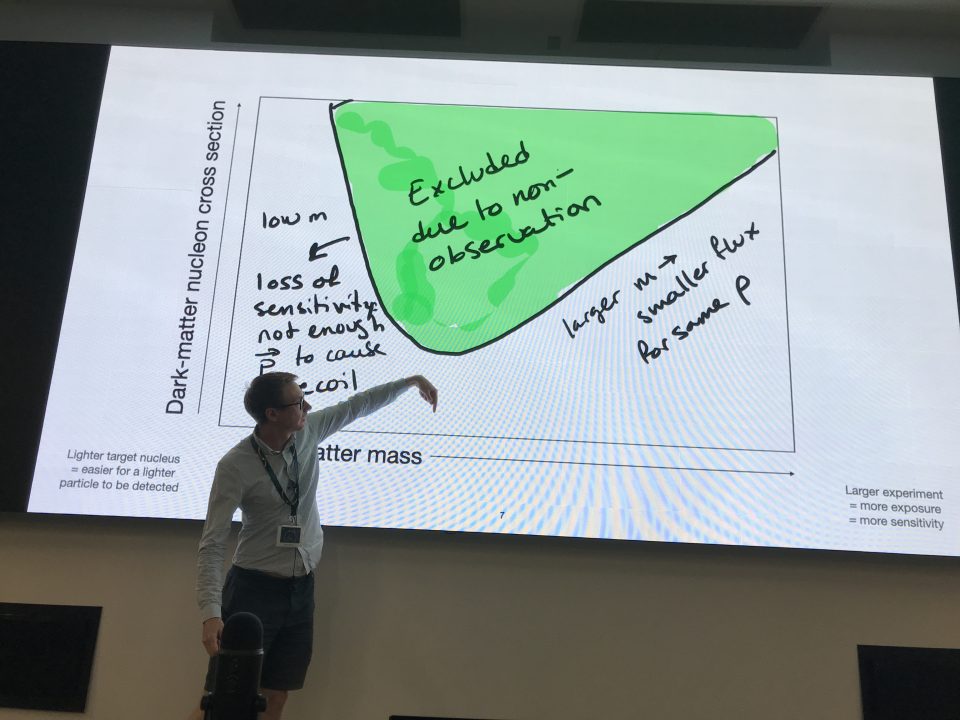
Dr. Aaron Vincent discussing the WIMP dark matter parameter space.
Early arrivals took part in two workshops. The afternoon featured a three-part networking session with interactive presentations by McDonald Institute Communications Officer Zac Kenny, Communications and Knowledge Mobilization expert Nanci Corrigan, and a panel on networking practices led by Erica Caden and Edward Thomas. In the evening, a guided performance of the KAIROS Blanket Exercise, was led by Wabaan Naang Collective facilitators Eunice Deconte and Sunshine Roundpoint.
NETWORKING 1
Zac Kenny reviewed problem-solving approaches to networking that encourage colleagues to exchange knowledge of each others’ research challenges (and potential solutions) to build meaningful and lasting networking conversations. Each step of this process was illustrated with a small breakout exercise.
NETWORKING 2
Nanci Corrigan introduced a framework for identifying people who can facilitate the elimination of barriers between goals and outcomes, while also improving clarity about the nature of problems we encounter in research.
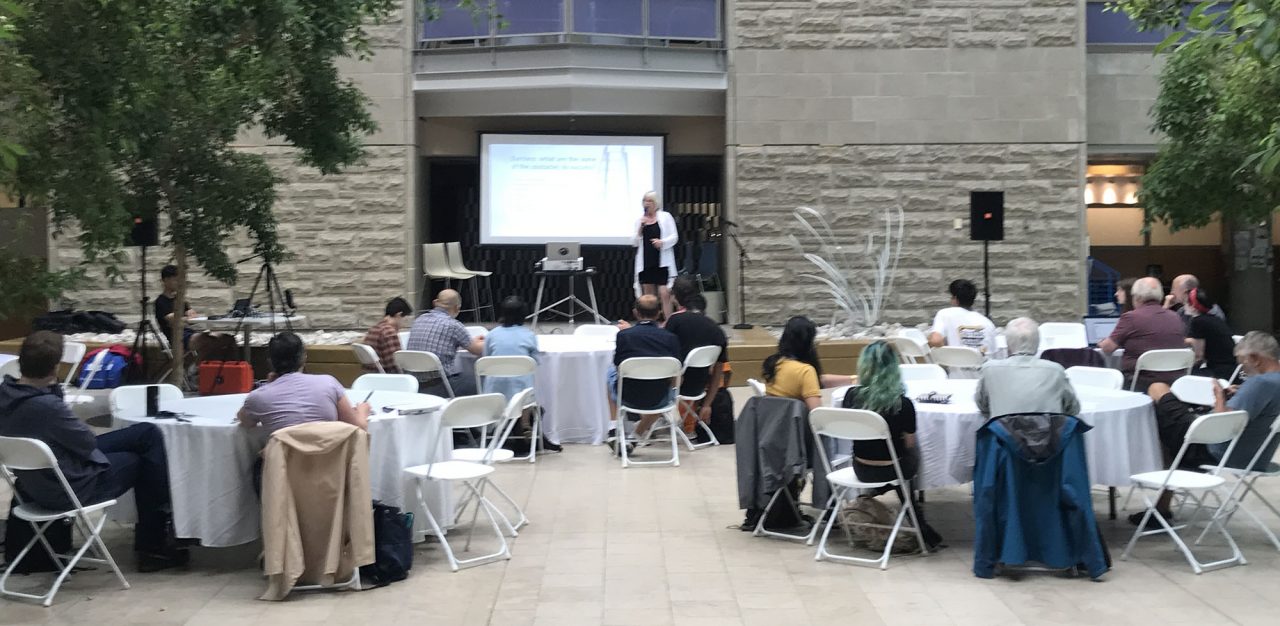
Nanci Corrigan discusses goal facilitators and barriers.
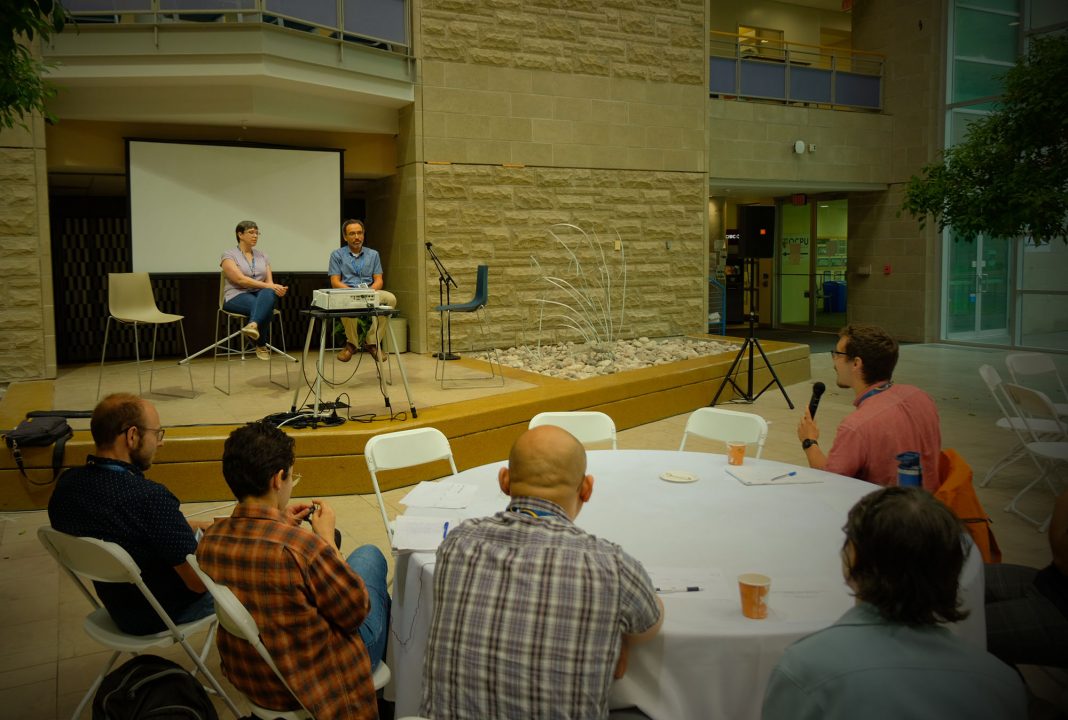
NETWORKING PANEL
The networking panel presentation covered a range of networking topics emphasizing on the uniqueness of individual perspectives and the oftentimes surprising value of information shared through good networking practice. Erica introduced the topic by illustrating how good networking creates opportunity for early career researchers. Edward introduced the topic by modeling how networking behaviour can be leadership-building at even the most junior level of organizational authority. Audience Q&A’s addressed, ways to best leverage professional gatherings, tools for managing personal network information, the potential impact of machine learning algorithms on digital networking tools, and ways to best navigate the social and political aspects of networking across many levels of seniority, authority or power.
KAIROS BLANKET EXERCISE
Thirty of this year’s community meeting attendees pre-registered to take part in the KAIROS Blanket Exercise, which uses kinesthetic participation to teach the history of settler-colonialism in Canada from an Indigenous perspective. The exercise, led by Wabaan Naang Collective facilitators Eunice Deconte and Sunshine Roundpoint, elicited important conversations about the ongoing impact of devastating violence, dispossession, government and church-sponsored abuses, marginalization, and ideological hostility. Attendees learned how these impacts directly affect our community on personal, professional and ethical levels.
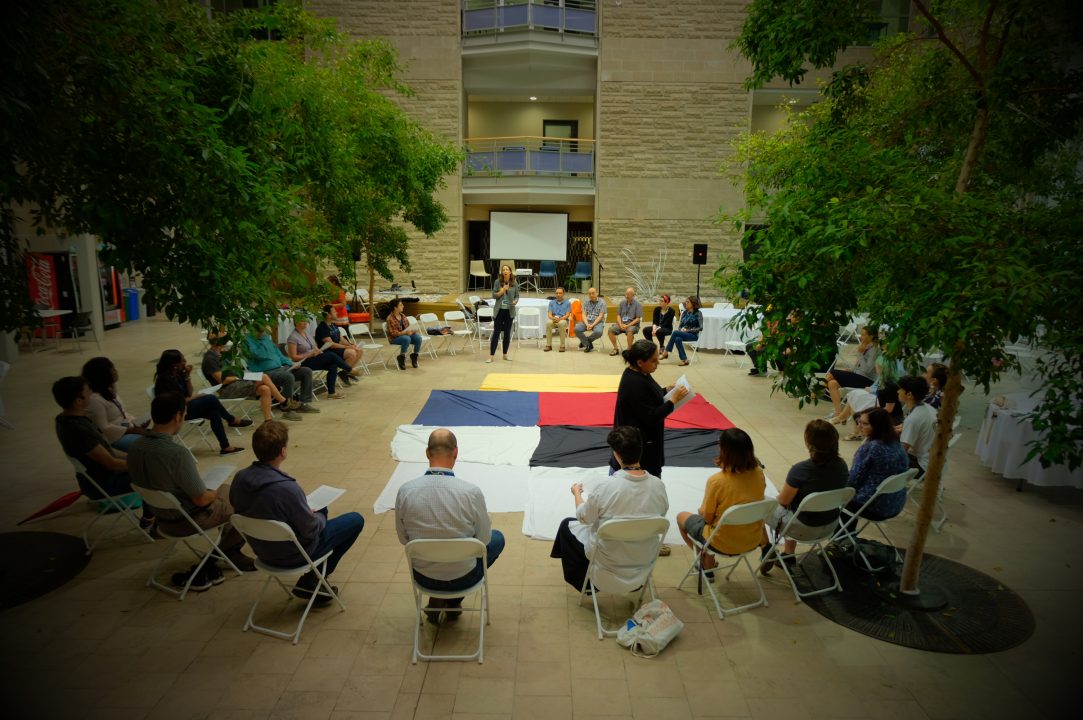
Meeting participants gather in a circle at the start of the Kairos Blanket Exercise.
Research Talks
SNO+ Update
Szymon Manecki (SNOLAB)
The SNO+ collaboration operates a kilo-tonne scale liquid scintillator detector at the SNOLAB underground facility in Sudbury, Canada. The primary physics goal of the experiment is to search for neutrinoless double beta decay with 130Te. The collaboration has been working towards this goal for over a decade, with many successful milestones achieved on the way. Between 2017 and 2019, the detector operated in a pure water phase, which helped in the evaluation of external backgrounds, and which also delivered exciting physics results on the invisible model of nucleon decay [PRD 99, 032008 (2019); PRD 105 112012 (2022)], updated 8B solar neutrino flux measurement [PRD 99, 012012 (2019)], neutron detection efficiency [PRC 102, 014002 (2020)] and first antineutrinos detected using only ultra-pure water [PRL 130, 091801 (2023)]. A pure scintillator phase started in 2022 and has been delivering quality data that will be used in various exciting physics publications in the near future. Finally, the tellurium underground systems have been undergoing process commissioning and will soon perform their first test runs. These activities will verify their performance and inform us about yields and efficiencies that will be critical in the final optimization of the process before the tellurium deployment in the detector.
Link to presentation materials
IceCube Update
Juan-Pablo Yanez (University of Alberta)
The IceCube collaboration is currently working on upgrading the detector. This upgrade involves deploying new sensors to recalibrate old data and improve the understanding of the ice. Additionally, new sensors will be deployed in the deep core region to lower the energy threshold and enable measurements related to neutrino oscillations and the rate of appearance of neutrinos. The deployment of these upgrades is expected to occur in 2026. The IceCube collaboration has made significant progress in astrophysical observations. They have observed a clear axis of neutrinos along the galactic plane, indicating the presence of astrophysical neutrinos. These observations have provided valuable insights into the production and propagation of neutrinos in the universe.
The IceCube collaboration is also looking towards the future with the proposed Gen2 project. Gen2 aims to create a massive array covering a larger volume than IceCube, having a higher effective area, and utilizing even newer sensors. This project is still in the proposal stage. Overall, the IceCube collaboration continues to collect and analyze data, make precision measurements, and explore new ways of looking at the data to search for new physics and further our understanding of astrophysical phenomena.
Link to presentation materials
Theory Update
Aaron Vincent (Queen’s University)
Aaron Vincent provided a theory update focused on the potential for dark matter in main sequence stars.
Dark matter makes up about 85% of the matter in the Universe, but its true nature still eludes us. Direct detection experiments around the world are searching for the small dark matter-nucleon interactions that would give us the first clue about its particle physics properties. If such interactions exist, they would also cause dark matter to become trapped inside stars. This can have consequences ranging from unobservable to extreme: small effects on neutrino fluxes detected at earth, asteroseismologial changes, and effects on the evolution of stars themselves. Detailed understanding of these effects requires complex modelling that still remains in its infancy after 30 years of theoretical work on the topic.
Link to presentation materials
HALO Update
Prof. Clarence Virtue (Laurentian University / SNOLAB)
Clarence Virtue updated the work of the HALO collaboration, discussing how neutrinos can take kinetic energy through interactions at the center of a star and deposit that energy elsewhere. This behaviour makes neutrinos efficient conductors of energy, even more so than photons, which are typically associated with stars. Photons have a specific path, while neutrinos, due to their weakly interacting nature, can move around and transfer energy more efficiently within a star.
Link to presentation materials
Gravitational Waves Update
Jessica McIver (Caltech; LIGO Lab, University of British Columbia)
The fourth LIGO-Virgo-KAGRA (LVK) observing run is currently underway; the LIGO detectors joined with improved sensitivities in May, and the LVK collaboration has been issuing roughly one significant gravitational-wave event alert every three days since the start of the run, despite significant challenges with environmental noise near the LIGO-Livingston detector. As the LVK uses these results to probe cosmology, dense baryonic matter, dark matter, and stellar remnant populations, there is great science potential for future gravitational-wave detectors on Earth and in space. We expect that near-future detectors in existing LIGO and Virgo vacuum chambers will register binary black hole mergers out to a redshift of 2, and LISA and next-generation ground-based facilities would allow us to probe new physics out to the dawn of cosmic time.
Link to presentation materials
SKA Observatory Update
Kristine Spekkens (Queen’s University/RMC)
Spekkens discussed a recently published scientific result featuring a ring of gas that was detected around a nearby galaxy, and the process through which the result was communicated to the public as a press release featuring a stunning composite image of the system:
https://apod.nasa.gov/apod/ap230913.html
https://www.queensu.ca/gazette/stories/what-happens-when-one-galaxy-swallows-another-galaxy
Spekkens contrasted the visuals that her group used to carry out the analysis that led to the result with the image that made it into the press release. The dichotomy between them raises questions about why we create images in science, who they are for, what purpose they serve, what makes an image that is effective at communicating science, and how collaborations between scientists and artists play an important role.
Link to presentation materials
P-ONE Update
Carsten Krauss (University of Alberta)
Neutrinos are highly exciting particles with many mysteries yet to be resolved. The new Canadian-based P-ONE collaboration is going to build a test detector for very high energy, extragalactic neutrinos in the deep Pacific Ocean. This system will establish that our Ocean Science partner Ocean Networks Canada (ONC) is able to make their underwater cabled deep-sea observatory available for neutrino measurements, that the deployment of long lines of instrumentation in the Pacific Ocean can be managed and it will allow the international P-ONE team to gather valuable ocean experience and the first neutrinos ever measured in the Pacific Ocean. P-ONE will construct the first detector lines in 2023 and 2024 and deploy them in early 2025.
Link to presentation materials
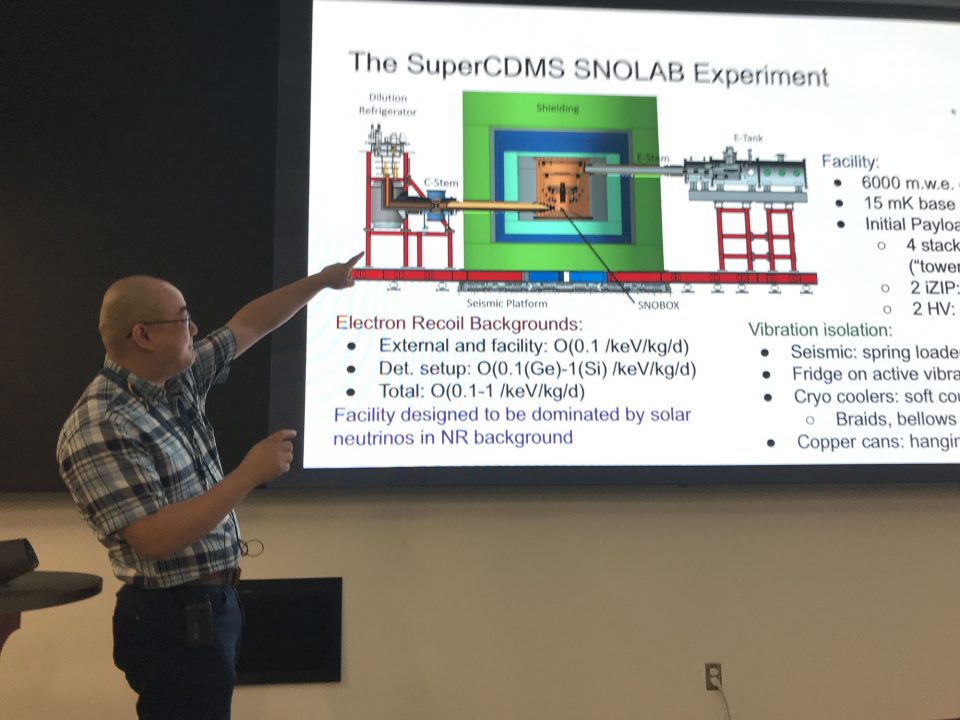
SuperCDMS Update
Ziqing Hong (University of Toronto)
SuperCDMS is looking for light dark matter signals with nuclear interactions in the GeV range and electron interactions below the MeV range. The experiment is under construction at SNOLAB. The dilution refrigerator, half of the detector payload, and all the data acquisition systems are already underground, with the base of its shield built. The preparation of data analysis is well underway. Meanwhile, the detector R&D program keeps pushing the boundary of cryogenic solid-state detectors.
Link to presentation materials
NEWS-G Update
Guillaume Giroux (Queen’s University)
The NEWS-G experiment searches for low-mass dark matter using low-threshold spherical proportional counters (SPCs) filled with low atomic mass gases. A 140-cm SPC in a compact shield was first installed at the Laboratoire Souterrain de Modane (LSM) and is now installed and operational at SNOLAB. A dark matter search was performed at LSM with a pure methane target. Preliminary results show world-leading constraints for low-mass WIMPs interacting with protons through spin-dependent interactions. A search for dark matter with a Neon target at SNOLAB was performed, and data analysis is underway. The NEWS-G collaboration is leading multiple efforts to understand the detector’s response to low-energy nuclear recoils using quasi-monoenergetic neutron beams and is set to address low-energy background with copper electroforming, in collaboration with the Pacific Northwest National Laboratory (PNNL) in the USA.
Link to presentation materials
Neutrinoless Double Beta Decay Update
Dr Erica Caden (SNOLAB)
Dr. Caden discusses the background measurements and technology used in the nEXO and LEGEND experiments, which aim to explore neutrino properties through neutrinoless double beta decay. The experiments focus on measuring the backgrounds and understanding the detector technology to improve the sensitivity and accuracy of the measurements. nEXO will use enriched Xenon-136 as the source and detector in a cryogenic time projection chamber. By combining measurements of light and charge, the experiment aims to reach a sensitivity of 1.35×10^28 years and a discovery potential of 0.7×10^28 years. For the LEGEND experiment, Caden highlights the use of germanium crystals with high energy resolution to distinguish between the double beta decay signal and the two-neutrino background. Overall, Caden emphasizes the importance of understanding and measuring the backgrounds, as well as the use of advanced detector technology, to improve the sensitivity and accuracy of the experiments.
Link to presentation materials
Future WIMPs
Joseph Bramante (Queen’s University & Perimeter Institute)
This talk gives an overview of dark matter models and search methods. Models of heavy dark matter are emphasized, including their connections to models of quark nugget dark matter from the 1980s and more modern, simplified composite dark matter models consisting of a fermion field bound together by a scalar. The sensitivity of large detectors for heavy dark matter is examined, including interstellar gas clouds, plastic etch detectors, very old minerals, and DEAP 3600. A simple measure for the scientific impact of dark matter experiments in terms of cross section and mass is proposed. According to this measure, heavy dark matter searches are rather economical at present.
Link to presentation materials
MATHUSLA Update
Miriam Deborah Joy Diamond (University of Toronto)
The world’s most powerful supercollider, the Large Hadron Collider (LHC) at CERN, is actively seeking to discover the identity of Beyond the Standard Model dark matter particles. But if they are neutral long-lived particles, the LHC may be producing them in copious numbers only to have them escape the main detectors. Adding a new detector, MATHUSLA (MAssive Timing Hodoscope for Ultra-Stable neutraL pArticles), on the surface above the LHC ring could catch the sneaky long-lived particles. It would also act as a cosmic ray telescope. The detector would consist of an empty decay volume instrumented with tracking layers, with each layer composed of plastic scintillator read out by wavelength-shifting fibers and silicon photomultipliers. A strong Canadian team has been working on R&D for detector components and design, preparing for the imminent release of a Conceptual Design Report followed by the construction of a prototype module for the High Luminosity LHC.
Link to presentation materials
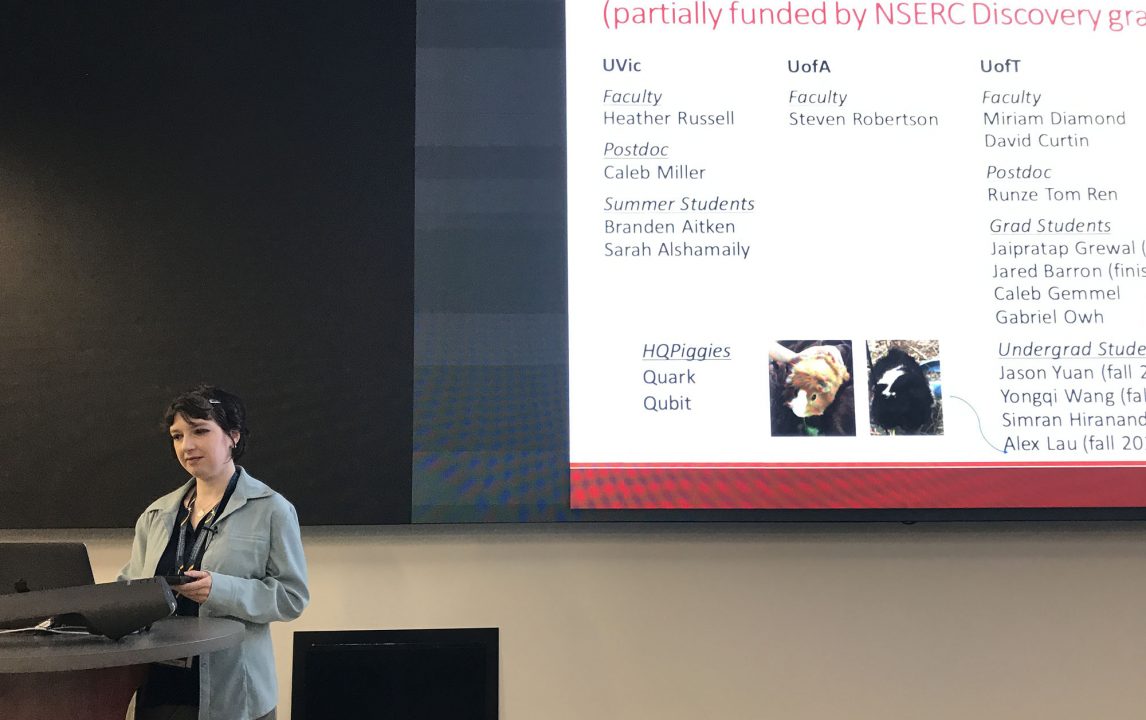
Miriam Diamond featuring her HQP (Highly Qualified Piggies)
SBC Update
Kenneth Clark (Queen’s University)
Link to presentation materials
Avalanche Detector update, from SiPM to dark matter search and beyond
Fabrice Retiere
Link to presentation materials
DEAP/DarkSide/ARGO Update
Mark Boulay (Carleton University)
Link to presentation materials
PICO Update
Alan Robinson (Université de Montréal)
Link to presentation materials
Tasks for the Next Decade of Astroparticle Physics: Talks and Panels
What Does the APP Community Need for Next 10 Years?
PANEL MODERATOR: Ken Clark
Jodi Cooley, Aksel Hallin, Nigel Smith and Fabrice Retiere were members of a panel discussion concerning the future trajectory of astroparticle physics in Canada. The discussion centred on Canada’s role in expansive international collaborations. An emphasis was placed on the necessity of ensuring sustained funding for major experiments. Moreover, there was a consensus on the importance of the strategic distribution of activities across key experiments at varied developmental stages.
The panel also underscored the significance of augmented Canadian inputs to already-established experiments. A key aspect of the discussion revolved around setting priorities for projects and streamlining Canadian endeavours. Projections for the coming decade include continued dark matter search across an array of mass scales, even as searches for supersymmetry (SUSY) might see a decline. Laboratories like SNOLAB showcase ambitious projects, but there’s notable competition from institutions such as the Boulby Underground Science Facility, which is expanding its experimental operations.
The panel emphasized the need for Canada to harness maximum potential by diving deep into major collaborations, while acknowledging that harmonizing the community’s interests towards singular flagship experiments is very challenging. A balance between supporting large-scale experiments and those of smaller or medium scales must be achieved. Furthermore, the discussion broached the subject of geopolitical intricacies that could potentially alter the dynamics of international alliances.
To navigate these challenges, potential strategies were proposed. Taking cues from SNOLAB’s record in fostering and preserving collaborations was identified as a key Canadian opportunity. Additionally, the community could benefit from incentivizing a focused approach on experimental resources. Crafting a pan-Canadian framework for project prioritization and coordination was highlighted as a key initiative. The panel also suggested capitalizing on the successes of TRIUMF’s technology transfer work.
Concluding the discussion, the panelists voiced their optimism, buoyed by Canada’s vanguard facilities and exceptional research prowess. They affirmed that the onward journey, promising as it is, hinges on robust leadership and a cohesive effort from the entire community.
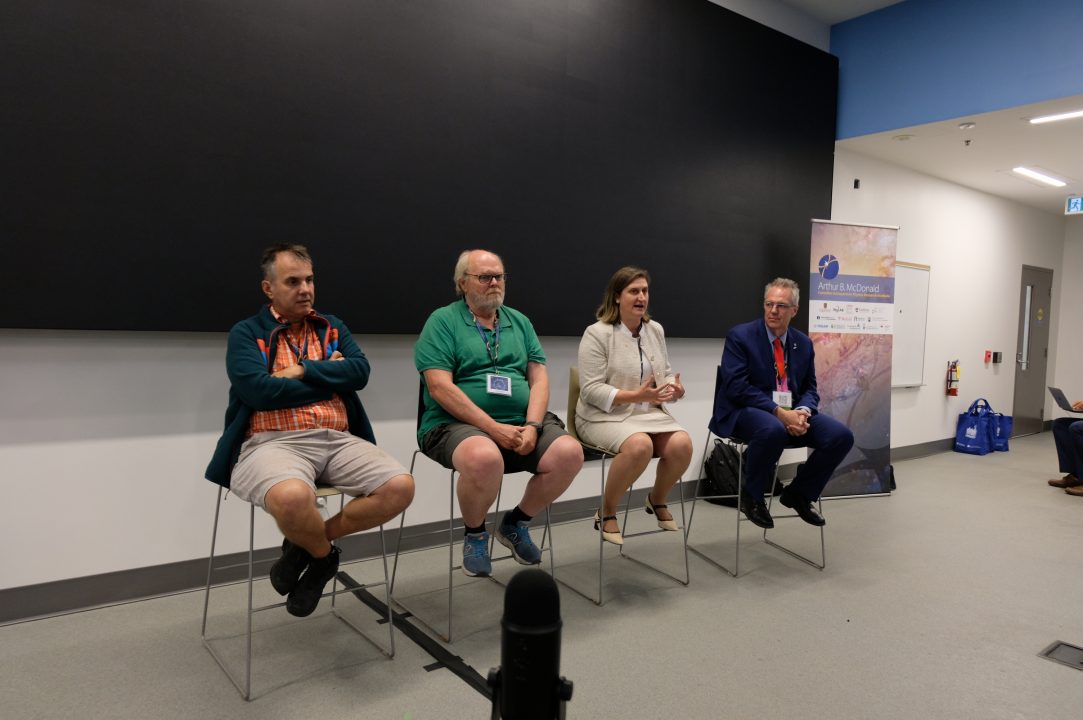
Fabrice Retiere, Aksel Hallin, Jodi Cooley, and Nigel Smith
McDonald Institute Future Update
PRESENTATION and Q&A: Tony Noble
The McDonald Institute’s Scientific Director, Tony Noble, discussed the future sustainability of the McDonald Institute, including the transition from the existing funding from CFREF and what it means. Queen’s led conversations with government have centred around addressing the “funding gap” where long-duration, multinational fundamental research does not seem to fit into current conventional funding streams.
The Institute is actively engaged in developing a funding model that would sustain support for scaled university-based research in astroparticle physics between the end of the CFREF grant and the possible emergence of new government funding programs designed to better support long-duration research. He discussed what is currently being considered and what might happen next if successful.
Tony also provided some thoughts on a longer-term strategy that makes the most sense within a framework for larger research investments, particularly with respect to engaging scientists and stakeholders in grassroots planning towards a long-term research framework that is inclusive of a broad range of needs and interests.
Salient points of this discussion included:
- The existing funding agreement with CFREF provides an automatic one-year extension to spend the remaining funds, which the Institute will engage. It has already applied for an additional 18-month no-cost extension due to COVID-19 delays. This does not increase the funding available through CFREF but does expand the timeframe for expending those funds (ending in 2025).
- Conversations with various stakeholders about possible extended funding support have been received positively, but funding decisions are not likely to emerge this fall.
- An Interim bridge-funding model with a budget of order $60M over five years has been developed as the baseline of what would be required to sustain research in astroparticle physics in Canada over the next five years. Key elements of the five-year budget include an emphasis on engineering resources, support for postdoctoral fellows, and inter-university collaboration support, with perhaps a couple of new faculty hires.
The long-term goal of the McDonald Institute is to align support of university-based APP researchers within a national framework that we hope will be established that supports research at major research facilities. Such an opportunity would stabilize funding of large facilities while optimizing their overall impact for Canadian science, innovation and economic development.
EDII for the Canadian APP Community
Samantha Kuula (SNOLAB Director of Corporate Services and EDI Lead) and Alexandra Pedersen (Manager for EDII Capacity Development) led an interactive workshop featuring the activity “paying for privilege”. This group activity highlighted unconscious bias, intersectionality, as well as how power and privilege operate within research and teaching spaces.
Towards Concerted Long-Term Funding Efforts for Canadian APP
PANEL MODERATOR: Edward Thomas
The panel discussion centred on various aspects of scientific research, funding, and support for major research facilities in Canada. The participants discussed key issues and challenges in the field, offering their perspectives on overcoming these obstacles.
Art McDonald spoke about the importance of government attention to long-term funding for research facilities. He highlighted the need for a “cradle to grave” approach, emphasizing continuity and long-term commitment rather than short-term grants. He also stressed the significance of collaboration and communication between universities, funding agencies, and experts to address technical difficulties.
Nancy Ross discussed the need for universities to collaborate more efficiently with the federal government. She emphasized that the collaborative effort requires people with different perspectives to work together and solve complex problems. She also noted the importance of outreach to increase public awareness of the value of large-scale scientific research.
Thomas Brunner raised concerns about securing funding for large-scale experiments with extended timelines. He emphasized the need for more support and the difficulty convincing universities and funding agencies to commit to long-term projects. He also noted the potential loss of valuable researchers if funding support diminishes.
The discussion revealed the intricate coordination and collaboration required for large-scale research projects in Canada. The speakers acknowledged the importance of continued government support, the need for long-term planning and funding, and the significance of maintaining technical expertise. They also highlighted the role of major research facilities as critical hubs for scientific advancement and the value of a collaborative approach within the scientific community.
The panelists concluded by emphasizing the need for a coordinated, national strategy to guide the development and support of large research facilities, acknowledging that each facility may have unique needs and requirements. They also highlighted the need for extended funding to ensure the sustainability and success of these projects and the necessity for the government to appreciate the importance of basic science in advancing our understanding of the universe.
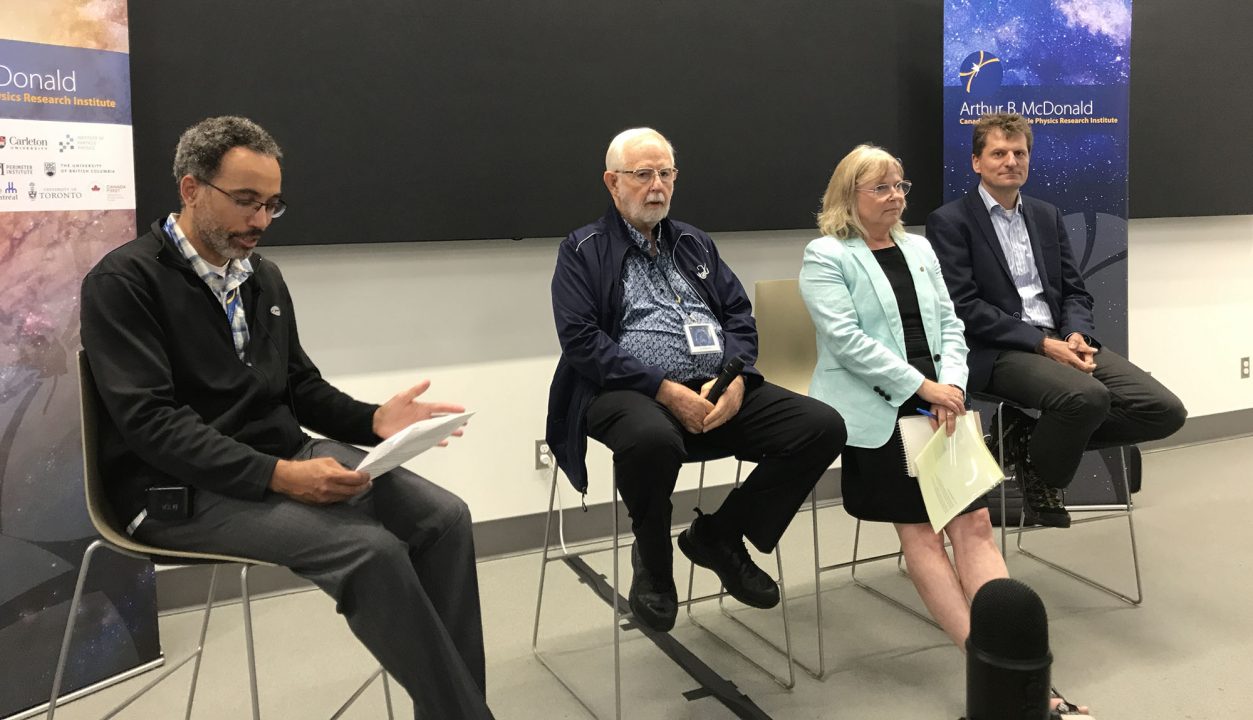
Edward Thomas, Art McDonald, Nancy Ross, and Thomas Brunner
Extra Curriculars
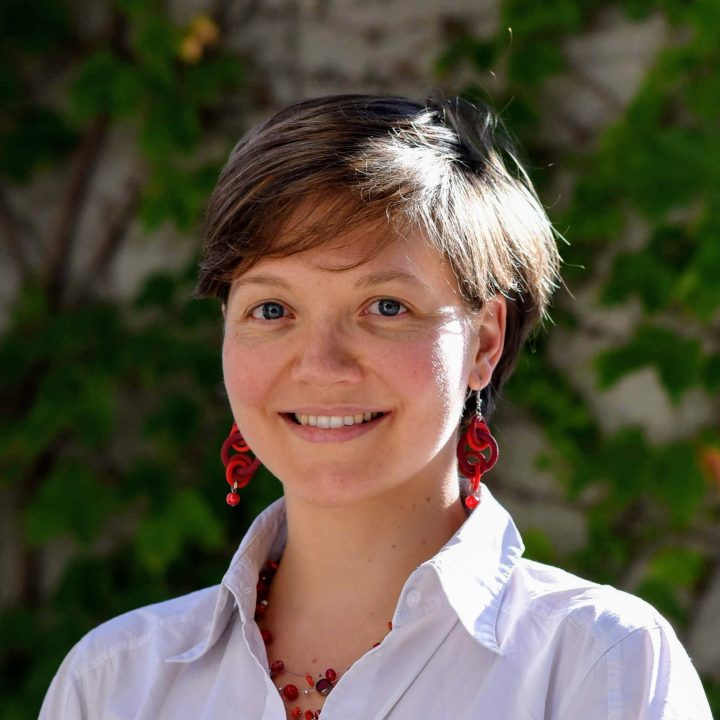
Claire David (AIMS)
McDonald Institute Ambassador, Dr. Claire David gave a talk about her adventurous career trajectory over the past year.
David recently completed her six-month journey through eight African countries. She’s been collaborating with research colleagues and teaching one hundred graduate students the mathematics behind artificial intelligences while also presenting on the ATLAS and DUNE collaborations she works on to thousands of university and high school students. Her recent work has taken her to university campuses in South Africa, Senegal, Benin, Togo, Democratic Republic of the Congo, Cameroon, Rwanda and Ghana.
She returned this fall to take up a new full-time position in Cape Town leading the development and delivery of post-graduate artificial intelligence training at the African Institute of Mathematical Sciences (AIMS).
Learn more about Dr. David’s recent work here.
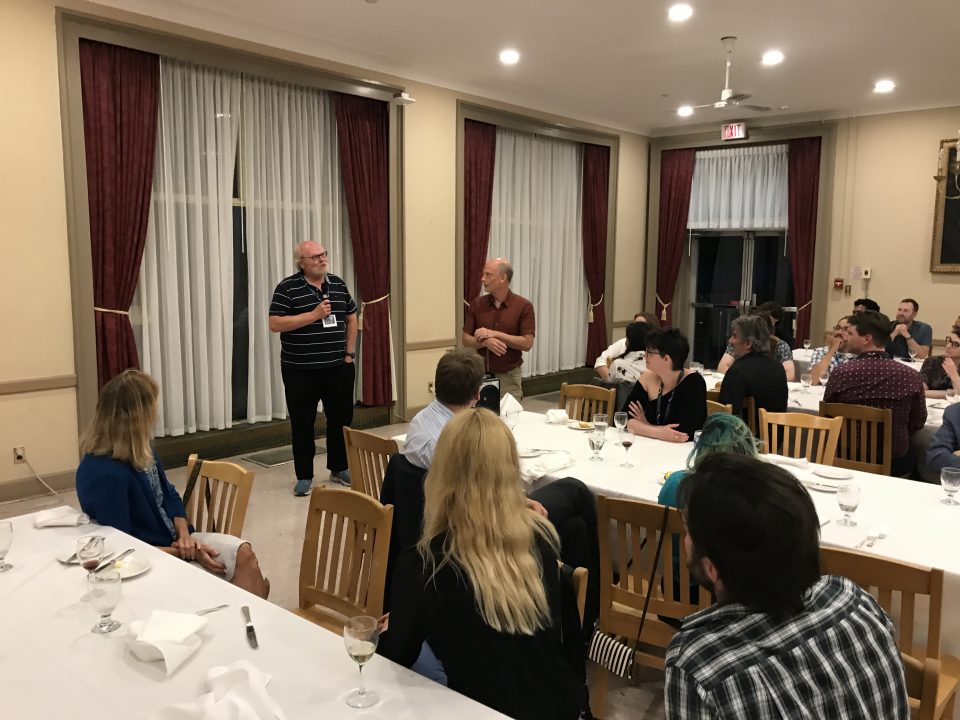
Gala Dinner
The meeting finished on Thursday, August 10th with a beautiful Gala Dinner at the Officer’s Mess at RMC. The community celebrated some significant events including the retirement of the accomplished Dr. Clarence Virtue. Attendees took the occasion to celebrate Art McDonald’s imminent 80th birthday, and many present shared stories of Art’s generous support, encouragement, and visionary brilliance over the years.
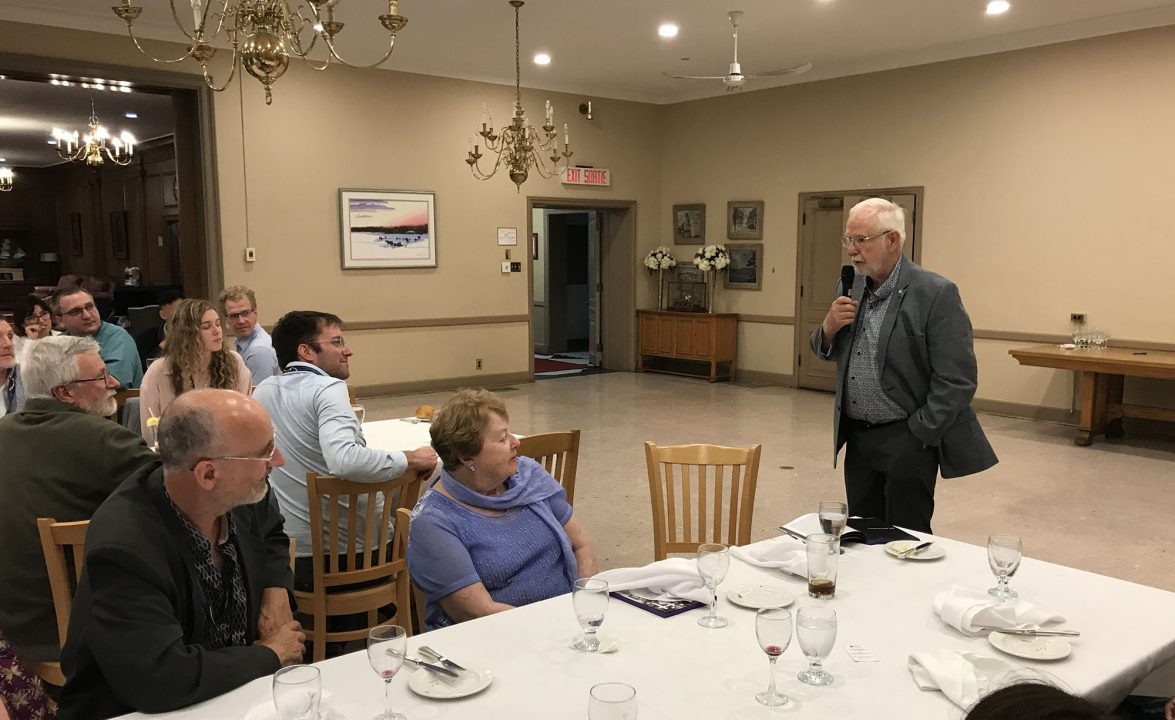
Art took to the mic to offer a few words of advice to the new generation of researchers: “Stay curious. Be kind. And work with good people”.
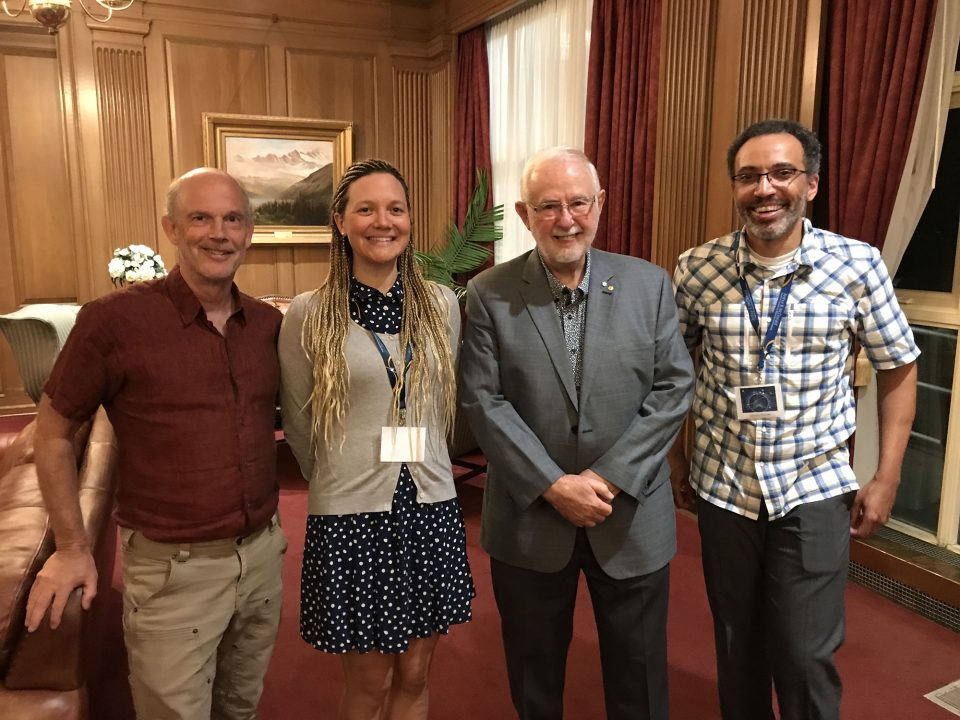
Tony Noble, Claire David, Art McDonald, and Edward Thomas
Special thanks to Edward Thomas for leading the meeting organization.
